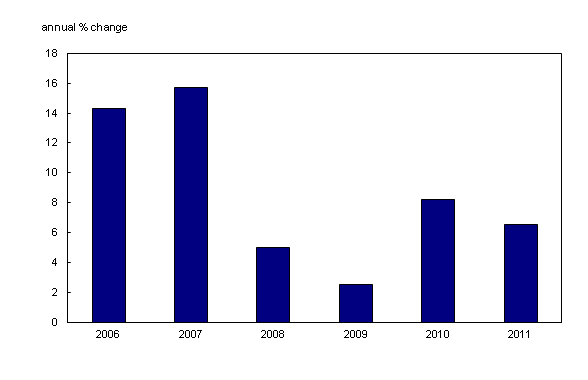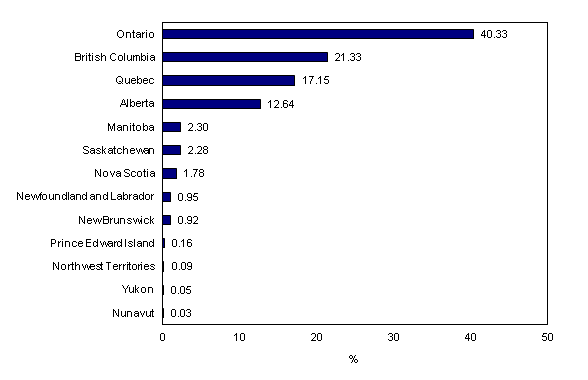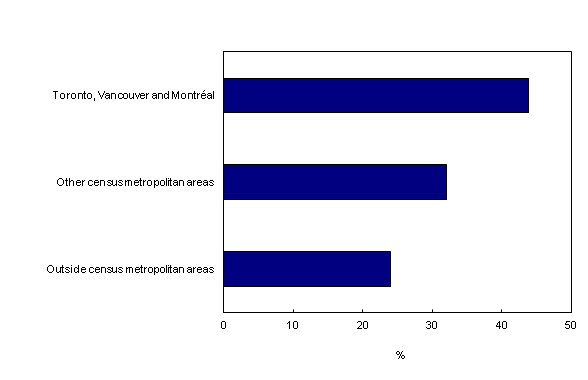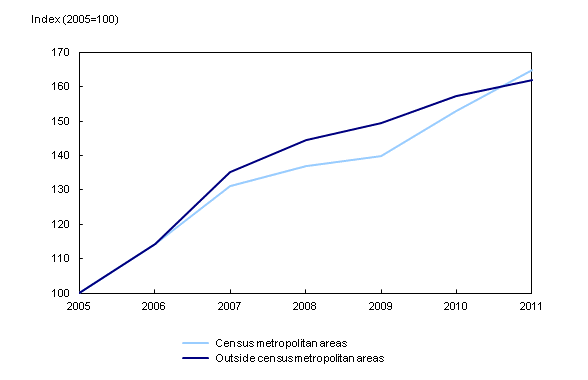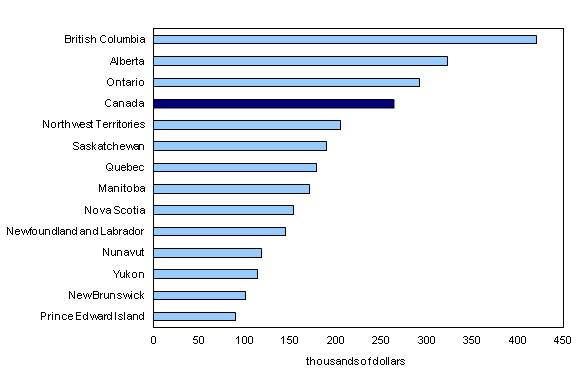Residential property values, 2011
Archived Content
Information identified as archived is provided for reference, research or recordkeeping purposes. It is not subject to the Government of Canada Web Standards and has not been altered or updated since it was archived. Please "contact us" to request a format other than those available.
Released: 2014-05-28
The total market value of residential properties in Canada was $3,838.2 billion in 2011, up 6.5% from 2010.
Much of the increase in value occurred in Ontario, British Columbia and Quebec. Together, these three provinces accounted for 88.7% of the annual increase.
Growth in residential property values eased in 2011 compared with 2010, but remained well above rates observed during the economic slowdown in 2008 and 2009.
Newfoundland and Labrador leads residential property values growth in 2011
The annual pace of growth was most rapid in Newfoundland and Labrador (+9.8%), Saskatchewan (+8.6%) and Ontario (+8.1%) in 2011.
The lowest rates of change in property values were in Prince Edward Island, where values declined 1.0%, and in Alberta, where growth was 0.7%.
In 2011, four provinces accounted for more than 90% of total national residential property values: Ontario with 40.3%, followed by British Columbia (21.3%), Quebec (17.2%) and Alberta (12.6%).
Values grow in nearly all census metropolitan areas in 2011
Residential property values in census metropolitan areas (CMAs) increased 7.7% between 2010 and 2011. After removing the effect of changes in CMA geographical boundaries, Thunder Bay (+15.3%) grew at the fastest rate, followed by Saint John (+11.1%) and Moncton (+11.0%). Values declined slightly in Calgary (-0.7%) and Victoria (-0.3%).
The value of the residential stock in Canada's CMAs totalled $2,915.3 billion in 2011, representing over three-quarters (76.0%) of the national total.
Toronto, Vancouver and Montréal, the three largest CMAs in terms of residential property values, accounted for 43.8% of Canada's total in 2011.
Other CMAs combined accounted for 32.1% of total residential property values, while non-CMA regions represented 24.0%.
The economic slowdown in 2008 and 2009 had a greater impact on growth in property values in CMAs than in non-CMA regions. In turn, as the economy recovered in 2010 and 2011, property values in CMAs (+17.7%) grew at a faster rate compared with regions outside CMAs (+8.2%).
British Columbia, Alberta and Ontario have the highest values per private dwelling in 2011
According to the 2006 and 2011 censuses, the number of private dwelling units rose by 7.3% to 14.6 million at the national level. Based on these dwelling counts, average residential property values per private dwelling increased 33.8% to $263,400 between 2006 and 2011.
These data indicate that much of the growth in values per private dwelling over the five inter-censal years from 2006 to 2011 resulted from increases in the prices of properties rather than in the number of properties.
The highest values per private dwelling in 2011 were in British Columbia ($420,800), Alberta ($322,400) and Ontario ($291,600), while the lowest were in Prince Edward Island ($90,200).
Among census metropolitan areas, values per private dwelling are highest in Vancouver
Canadian CMAs had average residential property values per private dwelling of $303,000 in 2011, up 32.8% from 2006.
In 2011, three of the top five CMAs in terms of average property values per private dwelling were in British Columbia. Vancouver led the way in 2011 at $535,500. Victoria ($392,200), Toronto ($388,200), Calgary ($386,800) and Kelowna ($361,100) comprised the rest of the top five.
Values per private dwelling were lowest in Trois-Rivières at $110,400, Moncton ($125,200) and Saint John ($130,400).
Note to readers
Residential property includes all types of property categorized as residential in the majority of provinces in the context of assessment for property tax purposes. It includes single- and multi-family properties, farm residences, cottages and vacation homes, mobile homes, institutional and communal residences as well as vacant lands for residential purposes.
Property values refer to the values of properties determined by provinces, territories and municipalities using a specific property assessment approach (cost, sales comparison or income) and adjusted by Statistics Canada to target price and volume dates of the reference year. For a given reference year, the target price date is July 1 and the volume state date is December 31.
For example, in reference year 2011, the price of properties is as of July 1, 2011, and the stock or volume is as of December 31, 2011.
For the purpose of this release, the census metropolitan area of Ottawa–Gatineau (Ontario/Quebec) is divided into two areas: Gatineau part and Ottawa part.
Estimates of total residential property values by territory are now available. These data should be used with caution as some of these estimates were produced by applying price adjustments to older assessment base dates. As more current data become available, significant revisions may occur.
The methodology used in the current release is different from that used in last year's release of residential property values (published in The Daily on April 25, 2013), where values were provided according to taxation year, which corresponds to the year following the value's reference year.
The methodology used in the current release differs from that used in the release on "Residential and non-residential property assessment values" (published in The Daily on November 22, 2013) to meet Finance Canada's data requirements for fiscal arrangements. For the purposes of fiscal arrangements, values represent taxable property values, expressed according to their taxation year, which corresponds to the year following the value's reference year.
For more information on the different approaches to measuring the stock of residential real estate, consult "Measuring the stock of residential real estate" in Latest Developments in the Canadian Economic Accounts (Catalogue number13-605-X).
Contact information
For more information, contact us (toll-free 1-800-263-1136; 514-283-8300; infostats@statcan.gc.ca).
To enquire about the concepts, methods or data quality of this release, contact Orane Saint-Denis (613-951-5112), Investment, Science and Technology Division.
- Date modified:


